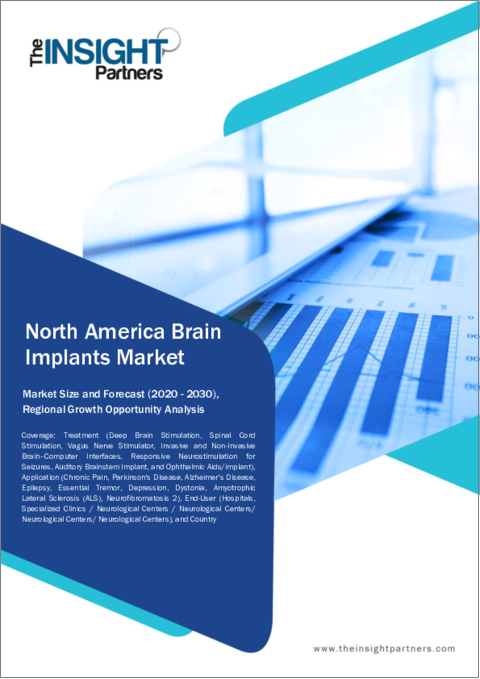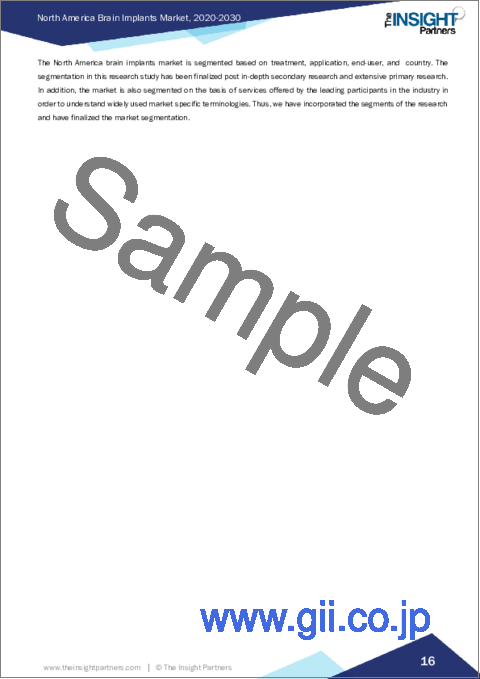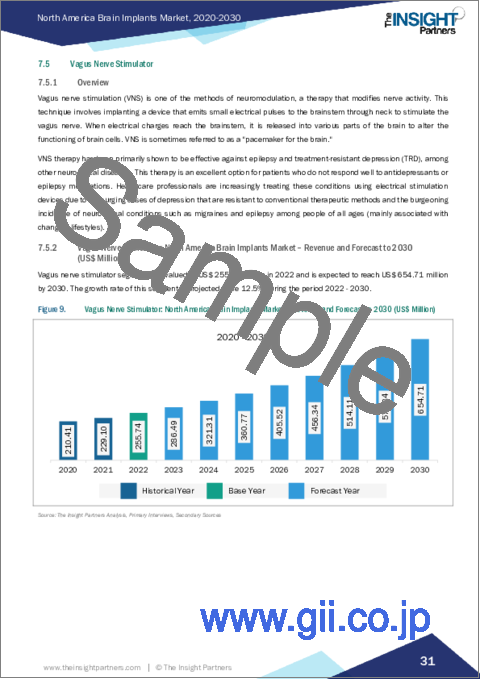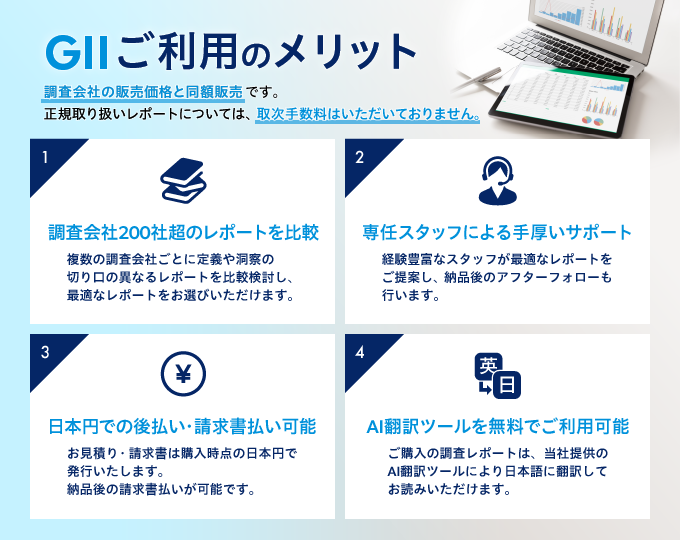|
|
市場調査レポート
商品コード
1494298
北米の脳インプラント市場予測(~2030年):地域別分析 - 治療、用途、エンドユーザー別North America Brain Implants Market Forecast to 2030 - Regional Analysis - by Treatment, Application, and End User (Hospitals and Specialized Clinics/Neurological Centers) |
||||||
|
|||||||
| 北米の脳インプラント市場予測(~2030年):地域別分析 - 治療、用途、エンドユーザー別 |
|
出版日: 2024年03月14日
発行: The Insight Partners
ページ情報: 英文 108 Pages
納期: 即納可能
|
全表示
- 概要
- 図表
- 目次
北米の脳インプラントの市場規模は、2022年に31億3,197万米ドルに達し、2022年~2030年にCAGR12.0%で成長し、2030年には77億6,872万米ドルに達すると予測されています。
高齢者人口の増加に伴う神経疾患の有病率の急増が北米の脳インプラント市場を活性化
加齢に伴い、高齢者は運動能力に影響を与える神経疾患を発症する可能性が高いです。アルツハイマー病、てんかん、パーキンソン病(PD)、ジストニアは、高齢者人口に影響を与える最も一般的な神経疾患の一つです。米国国勢調査局による2020年の人口統計によると、高齢者人口は5,580万人、すなわち国内人口の16.8%に達し、2020年には国内人口のほぼ6人に1人が65歳以上となります。さらに、フレーザー研究所が発表したデータによると、カナダの65歳以上人口の割合は2010年の14%から2022年には19%に増加し、2030年には22.5%に達すると予想されています。UpToDate Inc.が2021年8月に発表した記事によると、てんかんの罹患率は年齢とともに上昇し、75歳以上の患者で最も高くなっています。
米国やカナダなどの国々では、高齢者人口の増加に伴う運動障害や精神疾患の有病率が高くなっています。パーキンソン財団によると、パーキンソン病は平均年齢60歳で発症します。例えば、年間約9万人のアメリカ人がパーキンソン病と診断されています。米国では100万人近くがパーキンソン病患者であり、その数は2030年までに120万人に達すると予想されています。アルツハイマー病:2023年4月に発表された"Can deep brain stimulation help alzheimer's disease alzheimer's symptoms"(脳深部刺激は症状の緩和に役立つか)という記事によると、世界中で3,200万人のアルツハイマー病患者がいるといいます。BrightFocus Foundationが2022年10月に発表したAlzheimer's Disease Research Factsheetによると、米国では2022年に新たに50万人のアルツハイマー病患者が診断されました。アルツハイマー病の罹患率は年齢とともに増加します。65歳以上のアメリカ人のうち650万人がアルツハイマー病に罹患しており、その数は2050年までに1,270万人に達すると予想されています。2022年2月に発表された世界保健機関(WHO)の統計によると、約5,000万人がてんかんに苦しんでおり、これは世界で最も一般的な神経疾患のひとつです。
神経疾患の罹患率の増加は、高齢者人口の増加と相まって、疾患の治療と管理を目的とした脳インプラントの需要を牽引しています。脳深部刺激療法(DBS)は、てんかん発作時に患者の身体が薬物療法に対して示す治療反応が低く、手術に伴う成功率が低いため、てんかん症例の治療に用いられています。ノースカロライナ大学チャペルヒル校の調査チームは、DBSを使用して刺激できる新しいニューロンを脳内に生成したと主張しています。アルツハイマー病に対するDBSは、心臓のペースメーカーに似た埋め込み型装置と、脳の前庭部に軽い電気パルスを直接送る2本のワイヤーを使用します。電気刺激によって脳内の記憶回路を活性化し、その機能を研ぎ澄ますことができます。このように、DBSや迷走神経刺激などの神経インプラントは、PDやその他の神経疾患患者の治療にますます使用されるようになっています。
北米の脳インプラント市場概要
北米の脳インプラント市場は、米国、カナダ、メキシコに区分されます。2022年、米国はこの地域で最大の市場シェアを占めており、予測期間中もその優位性が続くと予測されています。パーキンソン病(PD)などの神経疾患の有病率の増加、神経疾患に対する意識の高まり、前向きな研究成果、さまざまな刺激装置の開発への投資の拡大などが、米国の脳インプラント市場全体の成長を促す主な要因となっています。パーキンソン財団によると、米国では2020年に93万人がPDに罹患しており、2030年には120万人に増加すると予測されています。脳深部刺激療法(DBS)などの脳インプラントは、PDの潜在的治療法であることが証明されています。DBSは、PDに伴う振戦を抑制するのに有効であることが確認されています。オレゴン健康科学大学(OSHU)脳研究所によると、米国では、本態性振戦の患者の約90%がDBS後に症状が中程度緩和されました。
2022年3月に発表された"2022 Alzheimer's disease facts and figures "と題された研究によると、2022年には65歳以上のアメリカ人のうち650万人がアルツハイマー病に罹患していることが判明しており、その数は2060年までに1,380万人に増加すると予測されています。さらに、主要な市場関係者は新バージョンのDBS装置の導入に注力しています。2023年3月、ミシガン工科大学の研究者たちは、ニューロモーフィック・コンピューティングを用いて、PD治療に用いられるDBSシステムの有効性とエネルギー効率を改善しました。同様に、ノースカロライナ大学チャペルヒル校の研究者たちは、DBSを使って脳内に新しいニューロンを生成し、それを刺激できることを発見しました。このプロセスは、アルツハイマー病モデルマウスの認知機能と非認知機能の回復に役立ちました。
技術の進歩と新製品の発売が米国の脳インプラント市場の成長を牽引しています。2020年1月、アボットのインフィニティDBSシステムがPD治療用として米国食品医薬品局(FDA)の承認を取得しました。このシステムは、PDの症状に関連する脳の特定部位(内側淡蒼球)をターゲットとします。2020年9月、ボストン・サイエンティフィックは、SCSシステムのWaveWriter Alphaポートフォリオを欧州で発売すると発表しました。2023年5月、アボット社が脊髄刺激装置(SCS)の承認を米国FDAより取得しました。2023年9月、ニューラリンク社は独立審査委員会から、麻痺患者を対象とした脳インプラントの初のヒト試験の募集開始の承認を受けました。この試験では、身体の動きを制御する脳の領域に、ロボットを使ってブレイン・コンピューター・インターフェイス(BCI)インプラントを外科的に設置します。
したがって、神経疾患の有病率の増加、研究開発活動の活発化、脳インプラントの技術的進歩が、今後の脳インプラント市場の成長を後押しすると予想されます。
北米の脳インプラント市場の収益と2030年までの予測(金額)
北米の脳インプラント市場セグメンテーション
北米の脳インプラント市場は、治療、用途、エンドユーザー、国に区分されます。
治療別では、北米の脳インプラント市場は、深部脳刺激、脊髄刺激、迷走神経刺激装置、侵襲的および非侵襲的脳コンピュータインターフェース、発作に対する応答性神経刺激、聴性脳幹インプラント、眼科補助/インプラントに分類されます。さらに、聴覚脳幹インプラントセグメントは、後耳性聴覚障害と蝸牛性聴覚障害に二分されます。脊髄刺激セグメントは2022年に最大のシェアを占めました。
用途別では、北米の脳インプラント市場は、慢性疼痛、パーキンソン病、アルツハイマー病、てんかん、本態性振戦、うつ病、ジストニア、筋萎縮性側索硬化症(ALS)、神経線維腫症2型に分類されます。
エンドユーザー別では、北米の脳インプラント市場は病院と専門クリニック/神経学センターに二分されます。病院セグメントが2022年に最大シェアを占めました。
国別では、北米の脳インプラント市場は米国、カナダ、メキシコに区分されます。米国は、2022年の北米の脳インプラント市場を独占しました。
Abbott Laboratories、Blackrock Microsystems Inc、Boston Scientific Corp、BrainGate、Fisher Wallace Laboratories Inc、Functional Neuromodulation Ltd、Medtronic Plc、Neuralink Corp、NeuroPace Inc、NeuroSky Inc、Neurospine LLC、ONWARD Medical NV、Paradromics Inc、Renishaw Plc、Synchron Incは、北米の脳インプラント市場で事業を展開している大手企業です。
目次
第1章 イントロダクション
第2章 エグゼクティブサマリー
- 主要な洞察
第3章 調査手法
- 調査範囲
- 2次調査
- 1次調査
第4章 北米の脳インプラント市場情勢
- 概観
- 北米のPEST分析
第5章 北米の脳インプラント市場-主要産業力学
- 主な市場促進要因
- 高齢者人口の増加に伴う神経疾患の有病率の急増
- 脊髄損傷の増加
- 主な市場抑制要因
- 脳インプラントデバイスおよび処置に伴う高コスト
- 主な市場機会
- 企業による戦略的取り組み
- 主な将来動向
- 小型化、人工知能、最新のブレイン・マシン・インターフェースなどの技術進歩
- 影響分析
第6章 脳インプラント市場:北米市場分析
- 北米の脳インプラント市場収益(2022年~2030年)
第7章 北米の脳インプラント市場 - 2030年までの収益と予測:治療別
- 北米の脳インプラント市場の収益シェア:治療別(2022年・2030年)
- 脳深部刺激療法
- 脊髄刺激
- 迷走神経刺激
- 侵襲的および非侵襲的脳コンピューター・インターフェース
- 発作に対する反応性神経刺激
- 聴覚脳幹インプラント
- 眼科補助具/インプラント
第8章 北米の脳インプラント市場 - 2030年までの収益と予測:用途別
- 北米の脳インプラント市場の収益シェア:用途別(2022年・2030年)
- 慢性疼痛
- パーキンソン病
- アルツハイマー病
- てんかん
- 本態性振戦
- うつ病
- ジストニア
- 筋萎縮性側索硬化症
- 神経線維腫症2型
第9章 北米の脳インプラント市場 - 2030年までの収益と予測:エンドユーザー別
- 北米の脳インプラント市場の収益シェア:エンドユーザー別(2022年・2030年)
- 病院
- 専門クリニック/神経センター
第10章 北米の脳インプラント市場:地域別分析
第11章 脳インプラント市場-業界情勢
- 脳インプラント市場の成長戦略
- 有機的成長戦略
- 無機的成長戦略
第12章 企業プロファイル
- Boston Scientific Corp
- Medtronic Plc
- Functional Neuromodulation Ltd
- Fisher Wallace Laboratories Inc
- Synchron Inc
- Blackrock Microsystems Inc
- Renishaw Plc
- Abbott Laboratories
- Neurospine LLC
- BrainGate
- NeuroSky Inc
- Neuralink Corp
- NeuroPace Inc
- ONWARD Medical NV
- Paradromics Inc
第13章 付録
List Of Tables
- Table 1. North America Brain Implants Market Segmentation
- Table 2. US: North America Brain Implants Market, by Treatment - Revenue and Forecast to 2030 (US$ Million)
- Table 3. US: North America Brain Implants Market, by Auditory Brainstem Implants- Revenue and Forecast to 2030 (US$ Million)
- Table 4. US: North America Brain Implants Market, by Application - Revenue and Forecast to 2030 (US$ Million)
- Table 5. US: North America Brain Implants Market, by End-User - Revenue and Forecast to 2030 (US$ Million)
- Table 6. Canada: North America Brain Implants Market, by Treatment - Revenue and Forecast to 2030 (US$ Million)
- Table 7. Canada: North America Brain Implants Market, by Auditory Brainstem Implants- Revenue and Forecast to 2030 (US$ Million)
- Table 8. Canada: North America Brain Implants Market, by Application - Revenue and Forecast to 2030 (US$ Million)
- Table 9. Canada: North America Brain Implants Market, by End-User - Revenue and Forecast to 2030 (US$ Million)
- Table 10. Mexico : North America Brain Implants Market, by Treatment - Revenue and Forecast to 2030 (US$ Million)
- Table 11. Mexico : North America Brain Implants Market, by Auditory Brainstem Implants- Revenue and Forecast to 2030 (US$ Million)
- Table 12. Mexico : North America Brain Implants Market, by Application - Revenue and Forecast to 2030 (US$ Million)
- Table 13. Mexico : North America Brain Implants Market, by End-User - Revenue and Forecast to 2030 (US$ Million)
- Table 14. Recent Organic Growth Strategies in Brain Implants Market
- Table 15. Recent Inorganic Growth Strategies in the Brain Implants Market
- Table 16. Glossary of Terms, North America Brain Implants Market
List Of Figures
- Figure 1. North America Brain Implants Market Segmentation, By Country
- Figure 2. North America PEST Analysis
- Figure 3. North America Brain Implants Market - Key Industry Dynamics
- Figure 4. Impact Analysis of Drivers and Restraints
- Figure 5. North America Brain Implants Market Revenue (US$ Mn), 2022 - 2030
- Figure 6. North America Brain Implants Market Revenue Share, by Treatment, 2022 & 2030 (%)
- Figure 7. Deep Brain Stimulation: North America Brain Implants Market - Revenue and Forecast to 2030 (US$ Million)
- Figure 8. Spinal Cord Stimulation: North America Brain Implants Market - Revenue and Forecast to 2030 (US$ Million)
- Figure 9. Vagus Nerve Stimulator: North America Brain Implants Market - Revenue and Forecast to 2030 (US$ Million)
- Figure 10. Invasive and Non-Invasive Brain-Computer Interfaces: North America Brain Implants Market - Revenue and Forecast to 2030 (US$ Million)
- Figure 11. Responsive Neurostimulation for Seizures: North America Brain Implants Market - Revenue and Forecast to 2030 (US$ Million)
- Figure 12. Auditory Brainstem Implant: North America Brain Implants Market - Revenue and Forecast to 2030 (US$ Million)
- Figure 13. Retrocochlear Hearing Impairment: North America Brain Implants Market - Revenue and Forecast to 2030 (US$ Million)
- Figure 14. Cochlear Hearing Impairment: North America Brain Implants Market - Revenue and Forecast to 2030 (US$ Million)
- Figure 15. Ophthalmic Aids/Implant: North America Brain Implants Market - Revenue and Forecast to 2030 (US$ Million)
- Figure 16. North America Brain Implants Market Revenue Share, by Application 2022 & 2030 (%)
- Figure 17. Chronic Pain: North America Brain Implants Market - Revenue and Forecast to 2030 (US$ Million)
- Figure 18. Parkinson's disease: North America Brain Implants Market - Revenue and Forecast to 2030 (US$ Million)
- Figure 19. Alzheimer's disease: North America Brain Implants Market - Revenue and Forecast to 2030 (US$ Million)
- Figure 20. Epilepsy: North America Brain Implants Market - Revenue and Forecast to 2030 (US$ Million)
- Figure 21. Essential Tremor: North America Brain Implants Market - Revenue and Forecast to 2030 (US$ Million)
- Figure 22. Depression: North America Brain Implants Market - Revenue and Forecast to 2030 (US$ Million)
- Figure 23. Dystonia: North America Brain Implants Market - Revenue and Forecast to 2030 (US$ Million)
- Figure 24. Amyotrophic Lateral Sclerosis (ALS): North America Brain Implants Market - Revenue and Forecast to 2030 (US$ Million)
- Figure 25. Neurofibromatosis 2: North America Brain Implants Market - Revenue and Forecast to 2030 (US$ Million)
- Figure 26. North America Brain Implants Market Revenue Share, by End-User, 2022 & 2030 (%)
- Figure 27. Hospitals: North America Brain Implants Market - Revenue and Forecast to 2030 (US$ Million)
- Figure 28. Specialized Clinics / Neurological Centers: North America Brain Implants Market - Revenue and Forecast to 2030 (US$ Million)
- Figure 29. North America: Brain Implants Market, by Key Country - Revenue (2022) (US$ Million)
- Figure 30. North America Brain Implants Market, By Key Countries, 2022 and 2030 (%)
- Figure 31. US: North America Brain Implants Market Revenue and Forecast to 2030 (US$ Mn)
- Figure 32. Canada: North America Brain Implants Market Revenue and Forecast to 2030 (US$ Mn)
- Figure 33. Mexico : North America Brain Implants Market Revenue and Forecast to 2030 (US$ Mn)
- Figure 34. Growth Strategies in Brain Implants Market
The North America brain implants market was valued at US$ 3,131.97 million in 2022 and is expected to reach US$ 7,768.72 million by 2030; it is estimated to grow at a CAGR of 12.0% from 2022 to 2030.
Surging Prevalence of Neurological Disorders with Increasing Geriatric Population Fuels North America Brain Implants Market
With age, elderly people are likely to develop neurological disorders that impact their mobility. Alzheimer's disease, epilepsy, Parkinson's disease (PD), and dystonia are among the most common neurological disorders affecting the geriatric population. According to the 2020 population statistics by the US Census Bureau, the geriatric population reached 55.8 million, i.e., 16.8% of the national population; nearly 1 in 6 people in the country were aged 65 and above in 2020. Further, as per the data published by the Fraser Institute, the share of Canada's population aged 65 or older increased from 14% in 2010 to 19% in 2022 and is expected to reach 22.5% by 2030. According to an article published by UpToDate Inc. in August 2021, the incidence rate of epilepsy rises with age and is highest among patients aged 75 and above.
Countries such as the US and Canada have high prevalence rates of movement disorders and psychiatric disorders associated with growing geriatric populations. According to the Parkinson's Foundation, Parkinson's symptoms are common at an average age of 60. For instance, ~90,000 Americans are diagnosed with PD yearly. The organization also states that the incidence of PD increases with age; nearly 1 million people in the US are living with PD, and the number is expected to reach 1.2 million by 2030. According to an article titled "Alzheimer's disease: Can deep brain stimulation help alleviate symptoms" published in April 2023, ~32 million people worldwide have Alzheimer's disease. As per the Alzheimer's Disease Research Factsheet, published by BrightFocus Foundation in October 2022, ~500,000 new cases of Alzheimer's disease were diagnosed in 2022 in the US. The incidence rate of Alzheimer's increases with age. ~6.5 million Americans aged 65 and above are suffering from Alzheimer's disease, and the number is expected to reach 12.7 million by 2050. According to the World Health Organization (WHO) stats released in February 2022, approximately 50 million people suffer from epilepsy, which is one of the most common neurological diseases worldwide.
The increasing incidence of neurological diseases, coupled with the growing geriatric population, drives the demand for brain implants to treat and manage the disease. The deep brain stimulation (DBS) technique is used to treat epilepsy cases due to the low therapeutic response exhibited by the patient's body to medication during seizures and reduced success rates associated with surgeries. Researchers from the University of North Carolina at Chapel Hill claim to have generated new neurons in the brain, which can be stimulated using DBS. DBS for Alzheimer's involves utilizing an implanted device similar to a heart pacemaker and two attached wires that deliver mild electrical pulses directly to the fornix area of the brain. Electrical stimulation can activate the memory circuitry in the brain to sharpen its function. Thus, neural implants such as DBS and vagus nerve stimulation are increasingly being used to treat patients with PD and other neurological conditions.
North America Brain Implants Market Overview
The North America brain implants market is segmented into the US, Canada, and Mexico. In 2022, the US held the largest market share in this region and is expected to continue its dominance during the forecast period. The increasing prevalence of neurological diseases such as Parkinson's disease (PD), growing awareness about neurological disorders, positive research results, and growing investments in developing various stimulators are among the main factors driving the overall market growth for brain implants in the US. According to the Parkinson's Foundation, 930,000 people in the US were suffering from PD in 2020, and the number is expected to increase to 1.2 million by 2030. Brain implants, such as deep brain stimulation (DBS), have proven to be potential treatment options for PD. DBS devices have been observed to be effective in controlling tremors associated with PD. As per the Oregon Health & Science University (OSHU) Brain Institute, in the US, ~90% of patients with essential tremors experienced moderate relief from symptoms after DBS.
According to a study titled "2022 Alzheimer's disease facts and figures," published in March 2022, ~6.5 million Americans aged 65 and above were found to have Alzheimer's disease in 2022, and the number is projected to rise to 13.8 million by 2060. Moreover, major market players focus on introducing new versions of DBS devices. In March 2023, researchers at Michigan Technological University used neuromorphic computing to improve the efficacy and energy efficiency of DBS systems used to treat PD. Similarly, researchers from the University of North Carolina at Chapel Hill discovered that they were able to generate new neurons in the brain and stimulate them using DBS. This process helped restore cognitive and noncognitive functions in a mouse model that had Alzheimer's disease.
Technological advancements and new product launches drive the growth of the US brain implants market. In January 2020, Abbott's Infinity DBS System received US Food and Drug Administration (FDA) approval for treating PD. This system targets a specific area of the brain (the inner globus pallidus), which is associated with the symptoms of PD. In September 2020, Boston Scientific announced the European launch of the WaveWriter Alpha portfolio of SCS systems. In May 2023, Abbott received approval from the US FDA for spinal cord stimulator (SCS) devices to treat chronic back pain in people who are not recommended to receive back surgery. In September 2023, Neuralink received approval from an independent review board to initiate recruitment for the first human trial of brain implants for paralysis patients. The study will involve a robot to surgically place a brain-computer interface (BCI) implant in the area of the brain that controls bodily movements.
Therefore, increasing prevalence of neurological diseases, rising research and development activities, and technological advancements in brain implants are expected to bolster the brain implants market growth in the future.
North America Brain Implants Market Revenue and Forecast to 2030 (US$ Million)
North America Brain Implants Market Segmentation
The North America brain implants market is segmented into treatment, application, end user, and country.
Based on treatment, the North America brain implants market is classified into deep brain stimulation, spinal cord stimulation, vagus nerve stimulator, invasive and non-invasive brain-computer interface, responsive neurostimulation for seizures, auditory brainstem implant, and ophthalmic aid/implant. Further, the auditory brainstem implant segment is bifurcated into retrocochlear hearing impairment and cochlear hearing impairment. The spinal cord stimulation segment held the largest share in 2022.
In terms of application, the North America brain implants market is categorized into chronic pain, Parkinson's disease, Alzheimer's disease, epilepsy, essential tremor, depression, dystonia, amyotrophic lateral sclerosis (ALS), and neurofibromatosis 2. The chronic pain segment held the largest share in 2022.
Based on end user, the North America brain implants market is bifurcated into hospitals and specialized clinics/neurological centers. The hospitals segment held the largest share in 2022.
Based on country, the North America brain implants market is segmented the US, Canada, and Mexico. The US dominated the North America brain implants market in 2022.
Abbott Laboratories, Blackrock Microsystems Inc, Boston Scientific Corp, BrainGate, Fisher Wallace Laboratories Inc, Functional Neuromodulation Ltd, Medtronic Plc, Neuralink Corp, NeuroPace Inc, NeuroSky Inc, Neurospine LLC, ONWARD Medical NV, Paradromics Inc, Renishaw Plc, and Synchron Inc are some of the leading companies operating in the North America brain implants market.
Table Of Contents
1. Introduction
- 1.1 The Insight Partners Research Report Guidance
- 1.2 Market Segmentation
2. Executive Summary
- 2.1 Key Insights
3. Research Methodology
- 3.1 Coverage
- 3.2 Secondary Research
- 3.3 Primary Research
4. North America Brain Implants Market Landscape
- 4.1 Overview
- 4.2 North America PEST Analysis
5. North America Brain Implants Market - Key Industry Dynamics
- 5.1 Key Market Drivers
- 5.1.1 Surging Prevalence of Neurological Disorders with Increasing Geriatric Population
- 5.1.2 Rising Number of Spinal Cord Injuries
- 5.2 Key Market Restraints
- 5.2.1 High Cost Associated with Brain Implant Devices and Procedures
- 5.3 Key Market Opportunities
- 5.3.1 Strategic Initiatives by Companies
- 5.4 Key Future Trends
- 5.4.1 Technological Advancements such as Miniaturization, Artificial Intelligence, and Modern Brain-Machine Interfaces
- 5.5 Impact Analysis:
6. Brain Implants Market - North America Market Analysis
- 6.1 Overview
- 6.2 North America Brain Implants Market Revenue (US$ Mn), 2022 - 2030
7. North America Brain Implants Market - Revenue and Forecast to 2030 - by Treatment
- 7.1 Overview
- 7.2 North America Brain Implants Market Revenue Share, by Treatment, 2022 & 2030 (%)
- 7.3 Deep Brain Stimulation
- 7.3.1 Overview
- 7.3.2 Deep Brain Stimulation: North America Brain Implants Market - Revenue and Forecast to 2030 (US$ Million)
- 7.4 Spinal Cord Stimulation
- 7.4.1 Overview
- 7.4.2 Spinal Cord Stimulation: North America Brain Implants Market - Revenue and Forecast to 2030 (US$ Million)
- 7.5 Vagus Nerve Stimulator
- 7.5.1 Overview
- 7.5.2 Vagus Nerve Stimulator: North America Brain Implants Market - Revenue and Forecast to 2030 (US$ Million)
- 7.6 Invasive and Non-Invasive Brain-Computer Interfaces
- 7.6.1 Overview
- 7.6.2 Invasive and Non-Invasive Brain-Computer Interfaces: North America Brain Implants Market - Revenue and Forecast to 2030 (US$ Million)
- 7.7 Responsive Neurostimulation for Seizures
- 7.7.1 Overview
- 7.7.2 Responsive Neurostimulation for Seizures: North America Brain Implants Market - Revenue and Forecast to 2030 (US$ Million)
- 7.8 Auditory Brainstem Implant
- 7.8.1 Overview
- 7.8.2 Auditory Brainstem Implant: North America Brain Implants Market - Revenue and Forecast to 2030 (US$ Million)
- 7.8.2.1 Retrocochlear Hearing Impairment
- 7.8.2.1.1 Retrocochlear Hearing Impairment: Auditory Brainstem Implants Market- Revenue and Forecast to 2030 (US$ Million)
- 7.8.2.2 Cochlear Hearing Impairment
- 7.8.2.2.1 Cochlear Hearing Impairment: Auditory Brainstem Implants Market- Revenue and Forecast to 2030 (US$ Million)
- 7.8.2.1 Retrocochlear Hearing Impairment
- 7.9 Ophthalmic Aids/Implant
- 7.9.1 Overview
- 7.9.2 Ophthalmic Aids/Implant: North America Brain Implants Market - Revenue and Forecast to 2030 (US$ Million)
8. North America Brain Implants Market - Revenue and Forecast to 2030 - by Application
- 8.1 Overview
- 8.2 North America Brain Implants Market Revenue Share, by Application 2022 & 2030 (%)
- 8.3 Chronic Pain
- 8.3.1 Overview
- 8.3.2 Chronic Pain: North America Brain Implants Market - Revenue and Forecast to 2030 (US$ Million)
- 8.4 Parkinson's disease
- 8.4.1 Overview
- 8.4.2 Parkinson's disease: North America Brain Implants Market - Revenue and Forecast to 2030 (US$ Million)
- 8.5 Alzheimer's disease
- 8.5.1 Overview
- 8.5.2 Alzheimer's disease: North America Brain Implants Market - Revenue and Forecast to 2030 (US$ Million)
- 8.6 Epilepsy
- 8.6.1 Overview
- 8.6.2 Epilepsy: North America Brain Implants Market - Revenue and Forecast to 2030 (US$ Million)
- 8.7 Essential Tremor
- 8.7.1 Overview
- 8.7.2 Essential Tremor: North America Brain Implants Market - Revenue and Forecast to 2030 (US$ Million)
- 8.8 Depression
- 8.8.1 Overview
- 8.8.2 Depression: North America Brain Implants Market - Revenue and Forecast to 2030 (US$ Million)
- 8.9 Dystonia
- 8.9.1 Overview
- 8.9.2 Dystonia: North America Brain Implants Market - Revenue and Forecast to 2030 (US$ Million)
- 8.10 Amyotrophic Lateral Sclerosis
- 8.10.1 Overview
- 8.10.2 Amyotrophic Lateral Sclerosis (ALS): North America Brain Implants Market - Revenue and Forecast to 2030 (US$ Million)
- 8.11 Neurofibromatosis 2
- 8.11.1 Overview
- 8.11.2 Neurofibromatosis 2: North America Brain Implants Market - Revenue and Forecast to 2030 (US$ Million)
9. North America Brain Implants Market - Revenue and Forecast to 2030 - by End-User
- 9.1 Overview
- 9.2 North America Brain Implants Market Revenue Share, by End-User, 2022 & 2030 (%)
- 9.3 Hospitals
- 9.3.1 Overview
- 9.3.2 Hospitals: North America Brain Implants Market - Revenue and Forecast to 2030 (US$ Million)
- 9.4 Specialized Clinics / Neurological Centers
- 9.4.1 Overview
- 9.4.2 Specialized Clinics / Neurological Centers: North America Brain Implants Market - Revenue and Forecast to 2030 (US$ Million)
10. North America Brain Implants Market - Geographical Analysis
- 10.1 North America North America Brain Implants Market, by Key Country-Revenue (2022)
- 10.1.1.1 North America North America Brain Implants Market, by Country
- 10.1.1.2 US
- 10.1.1.2.1 US: North America Brain Implants Market Revenue and Forecast to 2030 (US$ Mn)
- 10.1.1.2.2 US: North America Brain Implants Market, by Treatment, 2020-2030 (US$ Million)
- 10.1.1.2.2.1 US: North America Brain Implants Market, by Auditory Brainstem Implants, 2020-2030 (US$ Million)
- 10.1.1.2.3 US: North America Brain Implants Market, by Application, 2020-2030 (US$ Million)
- 10.1.1.2.4 US: North America Brain Implants Market, by End-User, 2020-2030 (US$ Million)
- 10.1.1.3 Canada
- 10.1.1.3.1 Canada: North America Brain Implants Market Revenue and Forecast to 2030 (US$ Mn)
- 10.1.1.3.2 Canada: North America Brain Implants Market, by Treatment, 2020-2030 (US$ Million)
- 10.1.1.3.2.1 Canada: North America Brain Implants Market, by Auditory Brainstem Implants, 2020-2030 (US$ Million)
- 10.1.1.3.3 Canada: North America Brain Implants Market, by Application, 2020-2030 (US$ Million)
- 10.1.1.3.4 Canada: North America Brain Implants Market, by End-User, 2020-2030 (US$ Million)
- 10.1.1.4 Mexico
- 10.1.1.4.1 Mexico : North America Brain Implants Market Revenue and Forecast to 2030 (US$ Mn)
- 10.1.1.4.2 Mexico: North America Brain Implants Market, by Treatment, 2020-2030 (US$ Million)
- 10.1.1.4.2.1 Mexico: North America Brain Implants Market, by Auditory Brainstem Implants, 2020-2030 (US$ Million)
- 10.1.1.4.3 Mexico: North America Brain Implants Market, by Application, 2020-2030 (US$ Million)
- 10.1.1.4.4 Mexico: North America Brain Implants Market, by End-User, 2020-2030 (US$ Million)
11. Brain Implants Market-Industry Landscape
- 11.1 Overview
- 11.2 Growth Strategies in Brain Implants Market
- 11.3 Organic Growth Strategies
- 11.3.1 Overview
- 11.4 Inorganic Growth Strategies
- 11.4.1 Overview
12. Company Profiles
- 12.1 Boston Scientific Corp
- 12.1.1 Key Facts
- 12.1.2 Business Description
- 12.1.3 Products and Services
- 12.1.4 Financial Overview
- 12.1.5 SWOT Analysis
- 12.1.6 Key Developments
- 12.2 Medtronic Plc
- 12.2.1 Key Facts
- 12.2.2 Business Description
- 12.2.3 Products and Services
- 12.2.4 Financial Overview
- 12.2.5 SWOT Analysis
- 12.2.6 Key Developments
- 12.3 Functional Neuromodulation Ltd
- 12.3.1 Key Facts
- 12.3.2 Business Description
- 12.3.3 Products and Services
- 12.3.4 SWOT Analysis
- 12.3.5 Key Developments
- 12.4 Fisher Wallace Laboratories Inc
- 12.4.1 Key Facts
- 12.4.2 Business Description
- 12.4.3 Products and Services
- 12.4.4 Financial Overview
- 12.4.5 SWOT Analysis
- 12.4.6 Key Developments
- 12.5 Synchron Inc
- 12.5.1 Key Facts
- 12.5.2 Business Description
- 12.5.3 Products and Services
- 12.5.4 SWOT Analysis
- 12.5.5 Key Developments
- 12.6 Blackrock Microsystems Inc
- 12.6.1 Key Facts
- 12.6.2 Business Description
- 12.6.3 Products and Services
- 12.6.4 SWOT Analysis
- 12.6.5 Key Developments
- 12.7 Renishaw Plc
- 12.7.1 Key Facts
- 12.7.2 Business Description
- 12.7.3 Products and Services
- 12.7.4 Financial Overview
- 12.7.5 SWOT Analysis
- 12.7.6 Key Developments
- 12.8 Abbott Laboratories
- 12.8.1 Key Facts
- 12.8.2 Business Description
- 12.8.3 Products and Services
- 12.8.4 Financial Overview
- 12.8.5 SWOT Analysis
- 12.8.6 Key Developments
- 12.9 Neurospine LLC
- 12.9.1 Key Facts
- 12.9.2 Business Description
- 12.9.3 Products and Services
- 12.9.4 SWOT Analysis
- 12.9.5 Key Developments
- 12.10 BrainGate
- 12.10.1 Key Facts
- 12.10.2 Business Description
- 12.10.3 Products and Services
- 12.10.4 SWOT Analysis
- 12.10.5 Key Developments
- 12.11 NeuroSky Inc
- 12.11.1 Key Facts
- 12.11.2 Business Description
- 12.11.3 Products and Services
- 12.11.4 SWOT Analysis
- 12.11.5 Key Developments
- 12.12 Neuralink Corp
- 12.12.1 Key Facts
- 12.12.2 Business Description
- 12.12.3 Products and Services
- 12.12.4 SWOT Analysis
- 12.12.5 Key Developments
- 12.13 NeuroPace Inc
- 12.13.1 Key Facts
- 12.13.2 Business Description
- 12.13.3 Products and Services
- 12.13.4 Financial Overview
- 12.13.5 SWOT Analysis
- 12.13.6 Key Developments
- 12.14 ONWARD Medical NV
- 12.14.1 Key Facts
- 12.14.2 Business Description
- 12.14.3 Products and Services
- 12.14.4 Financial Overview
- 12.14.5 SWOT Analysis
- 12.14.6 Key Developments
- 12.15 Paradromics Inc
- 12.15.1 Key Facts
- 12.15.2 Business Description
- 12.15.3 Products and Services
- 12.15.4 SWOT Analysis
- 12.15.5 Key Developments
13. Appendix
- 13.1 About Us
- 13.2 Glossary of Terms





